
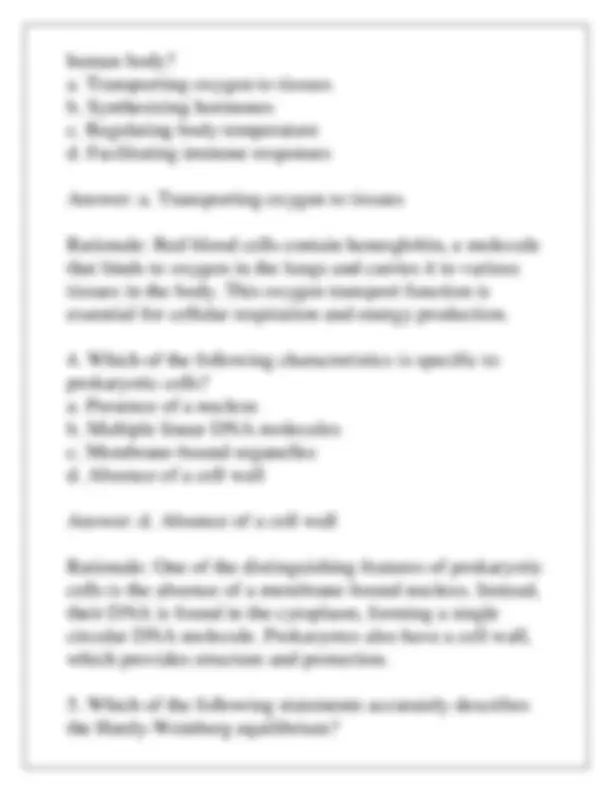
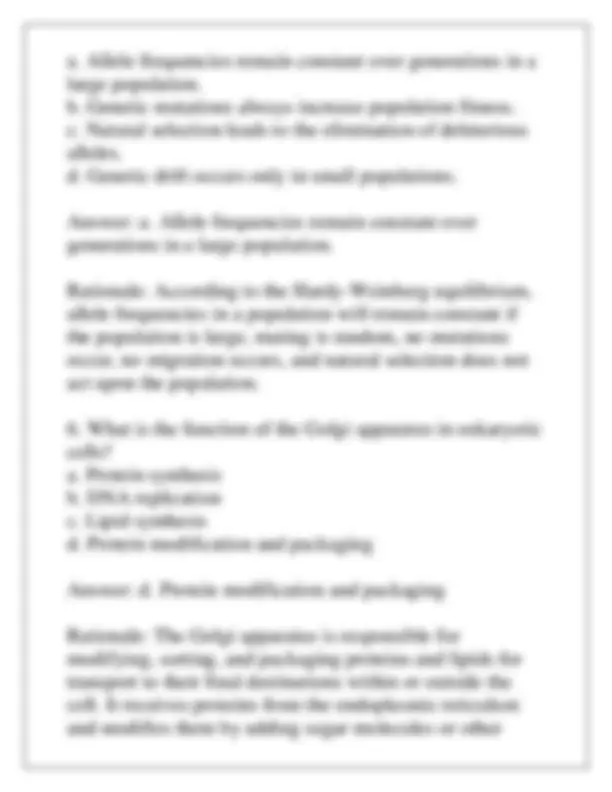
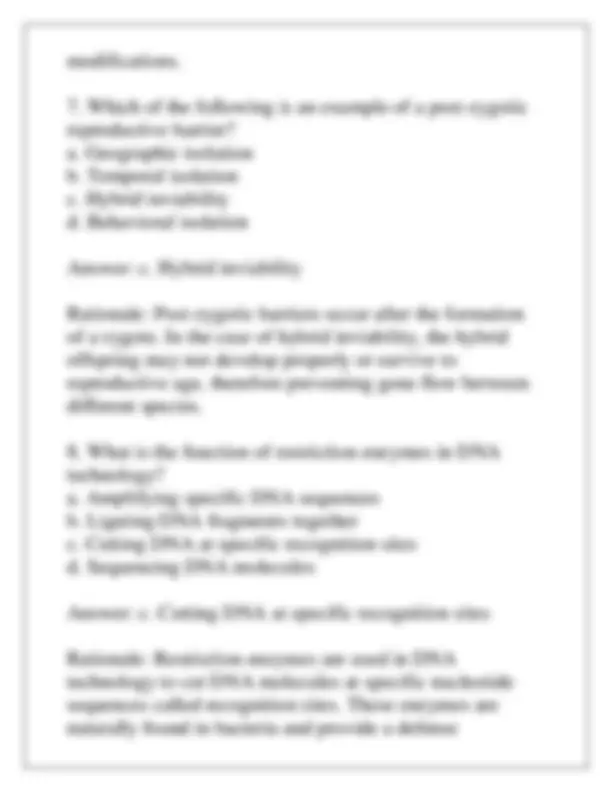
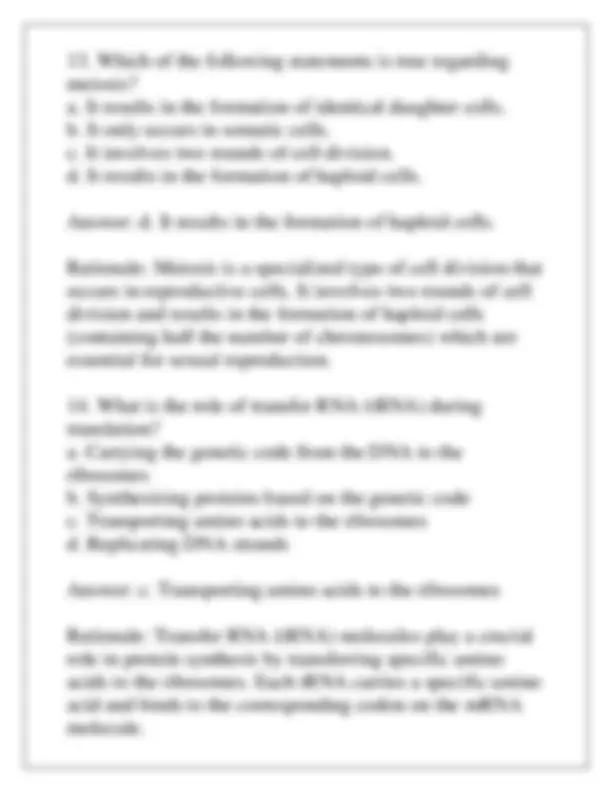


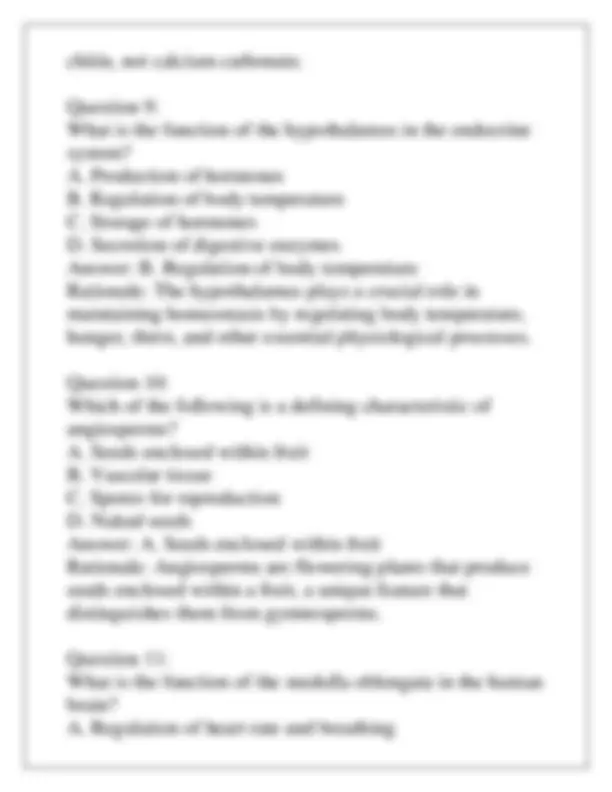
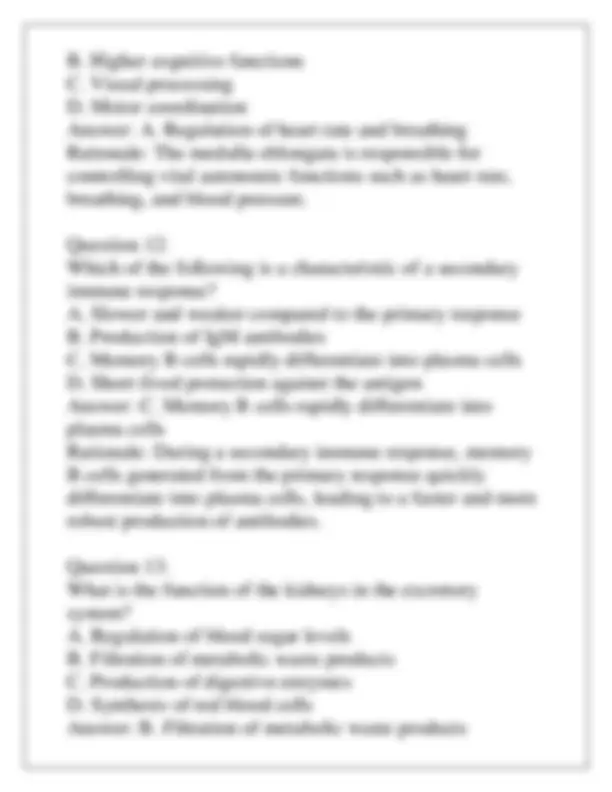
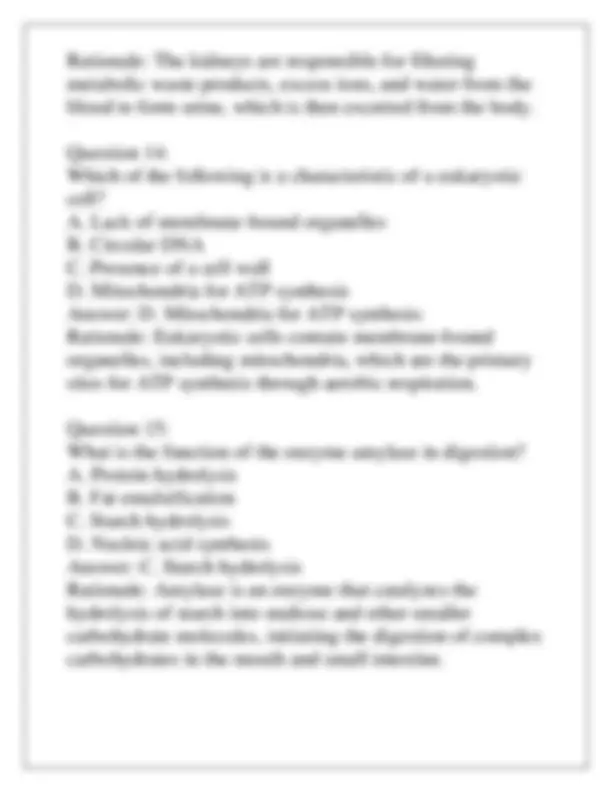
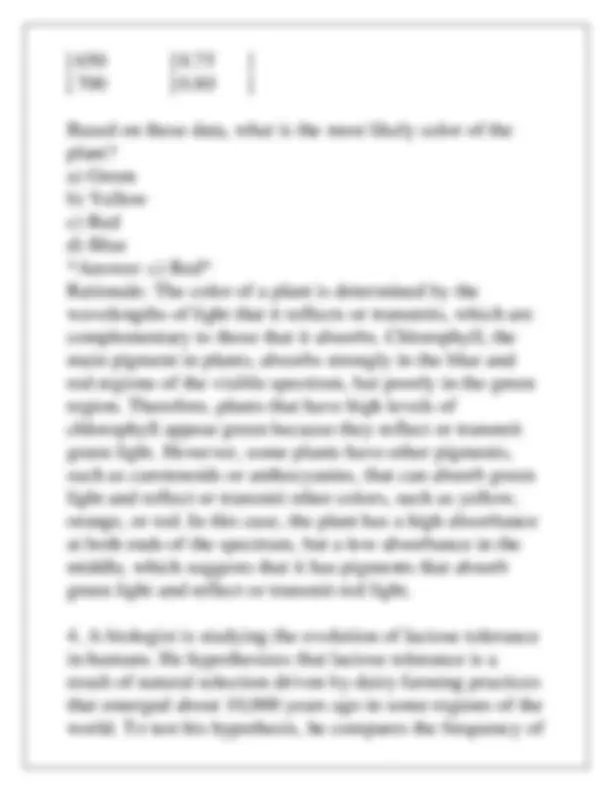
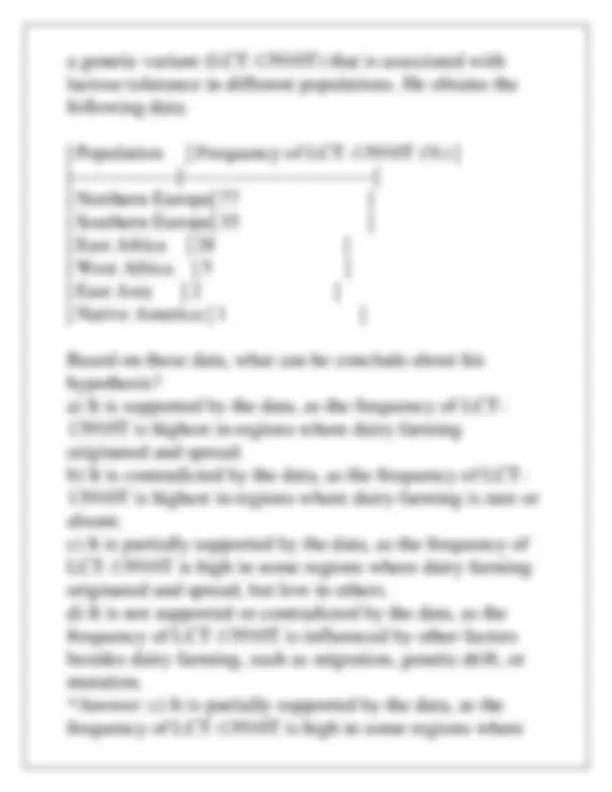
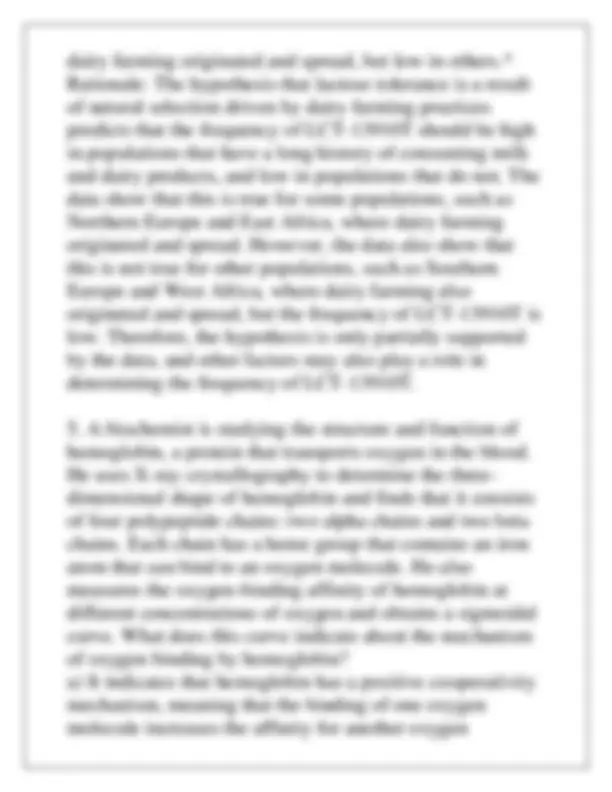




Study with the several resources on Docsity

Earn points by helping other students or get them with a premium plan


Prepare for your exams
Study with the several resources on Docsity

Earn points to download
Earn points by helping other students or get them with a premium plan
Community
Ask the community for help and clear up your study doubts
Discover the best universities in your country according to Docsity users
Free resources
Download our free guides on studying techniques, anxiety management strategies, and thesis advice from Docsity tutors
BSC1006 ADVANCED BIOLOGY EXAM Q & A 2024BSC1006 ADVANCED BIOLOGY EXAM Q & A 2024BSC1006 ADVANCED BIOLOGY EXAM Q & A 2024
Typology: Exams
1 / 22

This page cannot be seen from the preview
Don't miss anything!















a. Allele frequencies remain constant over generations in a large population. b. Genetic mutations always increase population fitness. c. Natural selection leads to the elimination of deleterious alleles. d. Genetic drift occurs only in small populations. Answer: a. Allele frequencies remain constant over generations in a large population. Rationale: According to the Hardy-Weinberg equilibrium, allele frequencies in a population will remain constant if the population is large, mating is random, no mutations occur, no migration occurs, and natural selection does not act upon the population.
modifications.
species benefit from the interaction, leading to coevolutionary adaptations. Question 2: What is the primary function of the Golgi apparatus in a cell? A. Protein synthesis B. Lipid synthesis C. Cellular respiration D. Protein modification and packaging Answer: D. Protein modification and packaging Rationale: The Golgi apparatus is responsible for modifying, sorting, and packaging proteins and lipids into vesicles for transportation to their final destination within the cell or for secretion. Question 3: Which of the following is a characteristic of prokaryotic cells? A. Presence of a nucleus B. Membrane-bound organelles C. Circular DNA D. Multicellularity Answer: C. Circular DNA Rationale: Prokaryotic cells lack a true nucleus and membrane-bound organelles. Instead, their genetic material is organized in a circular DNA molecule located in the nucleoid region of the cell. Question 4:
In which phase of the cell cycle does DNA replication occur? A. G1 phase B. S phase C. G2 phase D. M phase Answer: B. S phase Rationale: DNA replication takes place during the synthesis (S) phase of the cell cycle, where the genetic material is duplicated to ensure that each daughter cell receives a complete set of chromosomes. Question 5: What is the role of the enzyme RNA polymerase in gene expression? A. DNA replication B. Translation C. Transcription D. Post-translational modification Answer: C. Transcription Rationale: RNA polymerase is responsible for catalyzing the synthesis of an RNA strand complementary to a DNA template, a process known as transcription, which is the first step in gene expression. Question 6: Which of the following is an example of a polysaccharide? A. Glucose B. Fructose C. Starch
chitin, not calcium carbonate. Question 9: What is the function of the hypothalamus in the endocrine system? A. Production of hormones B. Regulation of body temperature C. Storage of hormones D. Secretion of digestive enzymes Answer: B. Regulation of body temperature Rationale: The hypothalamus plays a crucial role in maintaining homeostasis by regulating body temperature, hunger, thirst, and other essential physiological processes. Question 10: Which of the following is a defining characteristic of angiosperms? A. Seeds enclosed within fruit B. Vascular tissue C. Spores for reproduction D. Naked seeds Answer: A. Seeds enclosed within fruit Rationale: Angiosperms are flowering plants that produce seeds enclosed within a fruit, a unique feature that distinguishes them from gymnosperms. Question 11: What is the function of the medulla oblongata in the human brain? A. Regulation of heart rate and breathing
B. Higher cognitive functions C. Visual processing D. Motor coordination Answer: A. Regulation of heart rate and breathing Rationale: The medulla oblongata is responsible for controlling vital autonomic functions such as heart rate, breathing, and blood pressure. Question 12: Which of the following is a characteristic of a secondary immune response? A. Slower and weaker compared to the primary response B. Production of IgM antibodies C. Memory B cells rapidly differentiate into plasma cells D. Short-lived protection against the antigen Answer: C. Memory B cells rapidly differentiate into plasma cells Rationale: During a secondary immune response, memory B cells generated from the primary response quickly differentiate into plasma cells, leading to a faster and more robust production of antibodies. Question 13: What is the function of the kidneys in the excretory system? A. Regulation of blood sugar levels B. Filtration of metabolic waste products C. Production of digestive enzymes D. Synthesis of red blood cells Answer: B. Filtration of metabolic waste products
that cleaves the mRNA. b) It recruits an RNA-induced transcriptional silencing complex (RITS) that methylates the mRNA. c) It forms a double-stranded RNA (dsRNA) with the mRNA that triggers RNA interference (RNAi). d) It forms a stem-loop structure with the mRNA that blocks the ribosome binding site. Answer: a) It recruits an RNA-induced silencing complex (RISC) that cleaves the mRNA. Rationale: MiRNAs are small non-coding RNAs that regulate gene expression by binding to complementary sequences on target mRNAs and inhibiting their translation or stability. One of the main mechanisms by which miRNAs achieve this is by recruiting RISC, a protein complex that contains an endonuclease called Argonaute that cleaves the mRNA.
a genetic variant (LCT-13910T) that is associated with lactose tolerance in different populations. He obtains the following data:
| Population | Frequency of LCT-13910T (%) |
|---|---|
| Northern Europe | 77 |
| Southern Europe | 35 |
| East Africa | 28 |
| West Africa | 5 |
| East Asia | 2 |
| Native America | 1 |
Based on these data, what can he conclude about his hypothesis? a) It is supported by the data, as the frequency of LCT- 13910T is highest in regions where dairy farming originated and spread. b) It is contradicted by the data, as the frequency of LCT- 13910T is highest in regions where dairy farming is rare or absent. c) It is partially supported by the data, as the frequency of LCT-13910T is high in some regions where dairy farming originated and spread, but low in others. d) It is not supported or contradicted by the data, as the frequency of LCT-13910T is influenced by other factors besides dairy farming, such as migration, genetic drift, or mutation. *Answer: c) It is partially supported by the data, as the frequency of LCT-13910T is high in some regions where
dairy farming originated and spread, but low in others.* Rationale: The hypothesis that lactose tolerance is a result of natural selection driven by dairy farming practices predicts that the frequency of LCT-13910T should be high in populations that have a long history of consuming milk and dairy products, and low in populations that do not. The data show that this is true for some populations, such as Northern Europe and East Africa, where dairy farming originated and spread. However, the data also show that this is not true for other populations, such as Southern Europe and West Africa, where dairy farming also originated and spread, but the frequency of LCT-13910T is low. Therefore, the hypothesis is only partially supported by the data, and other factors may also play a role in determining the frequency of LCT-13910T.